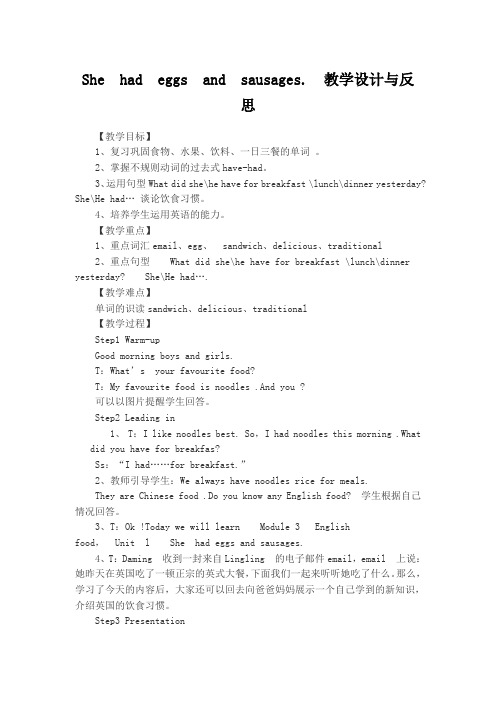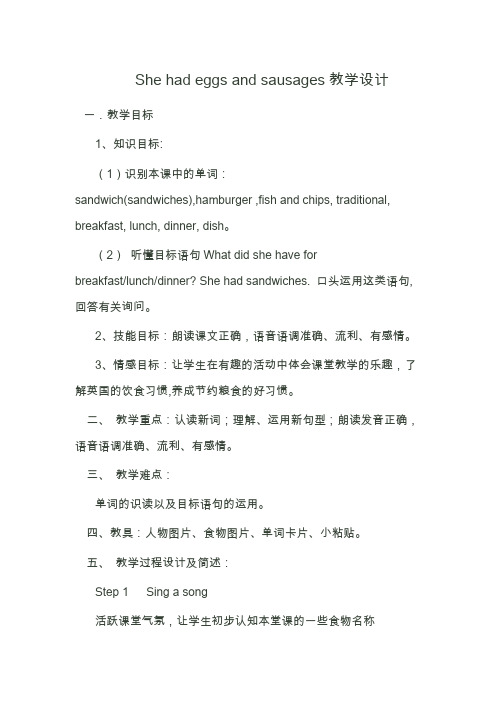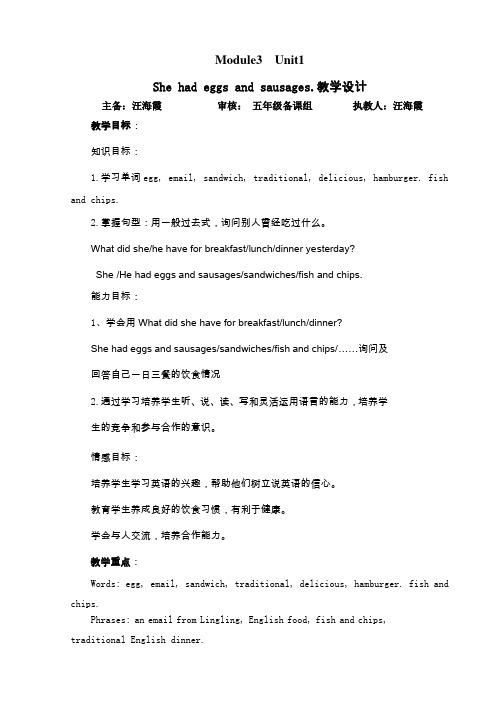She-had-eggs-and-sausages.教学设计 (1)
- 格式:doc
- 大小:77.50 KB
- 文档页数:5

She had eggs and sausages. 教学设计与反思【教学目标】1、复习巩固食物、水果、饮料、一日三餐的单词。
2、掌握不规则动词的过去式have-had。
3、运用句型What did she\he have for breakfast \lunch\dinner yesterday? She\He had…谈论饮食习惯。
4、培养学生运用英语的能力。
【教学重点】1、重点词汇email、egg、sandwich、delicious、traditional2、重点句型What did she\he have for breakfast \lunch\dinner yesterday? She\He had….【教学难点】单词的识读sandwich、delicious、traditional【教学过程】Step1 Warm-upGood morning boys and girls.T:What’s your favourite food?T:My favourite food is noodles .And you ?可以以图片提醒学生回答。
Step2 Leading in1、T:I like noodles best. So,I had noodles this morning .Whatdid you have for breakfas?Ss:“I had……for breakfast.”2、教师引导学生:We always have noodles rice for meals.They are Chinese food .Do you know any English food? 学生根据自己情况回答。
3、T:Ok !Today we will learn Module 3 Englishfood,Unit l She had eggs and sausages.4、T:Daming 收到一封来自Lingling 的电子邮件email,email 上说:她昨天在英国吃了一顿正宗的英式大餐,下面我们一起来听听她吃了什么。

She had eggs and sausages教学设计一.教学目标1、知识目标:(1)识别本课中的单词:sandwich(sandwiches),hamburger ,fish and chips, traditional, breakfast, lunch, dinner, dish。
(2)听懂目标语句What did she have forbreakfast/lunch/dinner? She had sandwiches. 口头运用这类语句,回答有关询问。
2、技能目标:朗读课文正确,语音语调准确、流利、有感情。
3、情感目标:让学生在有趣的活动中体会课堂教学的乐趣,了解英国的饮食习惯,养成节约粮食的好习惯。
二、教学重点:认读新词;理解、运用新句型;朗读发音正确,语音语调准确、流利、有感情。
三、教学难点:单词的识读以及目标语句的运用。
四、教具:人物图片、食物图片、单词卡片、小粘贴。
五、教学过程设计及简述:Step 1 Sing a song活跃课堂气氛,让学生初步认知本堂课的一些食物名称Step 2 Free-TalkWhat’s your favourite food?(贴近生活,鼓励学生大胆发言,旧知引入新知,通过出示实物图片及总结,引出English food)Step 3 Leading-in通过让学生猜一猜What did I have for breakfast?引出目标语句What did you have for breakfast?学生回答I had…老师转述She/He had…..从而引出课文标题Module 3 Unit 1 She had eggs and sausages.学生齐读课题Step 4 Text1、What’s the email about?2、①What did lingling have for breakfast?②What did she have for lunch?③What did she have for dinner?通过回答问题再次巩固新单词traditional(tra di tional 化多为少教。

She Had Eggs and Sausages 教学设计教案一、教学目标1. 知识目标:学生能够正确理解并使用句子"She had eggs and sausages." 来描述某人的早餐。
学生能够听懂并能够用简单的英语描述自己的早餐。
2. 技能目标:学生能够通过听力练习,提高对英语听力的理解能力。
学生能够在小组活动中用英语进行简单的交流。
3. 情感目标:学生能够对英语学习保持积极的态度,增强学习英语的自信心。
二、教学重难点1. 教学重点:学生能够正确理解和使用句子"She had eggs and sausages."学生能够通过听力练习,提高对英语听力的理解能力。
2. 教学难点:学生能够在实际情景中,运用句子"She had eggs and sausages." 来描述某人的早餐。
三、教学方法1. 情境教学法:通过设置早餐场景,让学生在实际情境中学习和使用句子"She had eggs and sausages."2. 交际教学法:通过小组活动,让学生在实际交流中运用所学知识。
3. 听力教学法:通过听力练习,提高学生的听力理解能力。
四、教学过程1. 引入:教师通过提问方式引导学生思考关于早餐的话题,例如"What did you have for breakfast?" 学生可以回答自己的早餐,教师引导学生用英语进行回答。
2. 新课呈现:教师展示一幅早餐的图片,引导学生观察并说出图片中的食物。
教师引入句子"She had eggs and sausages.",解释句子的意思,并让学生跟读句子。
3. 听力练习:教师播放一段听力材料,内容是一个人在描述自己的早餐。
学生需要听懂材料并能够回答问题,例如"What did she have for breakfast?"4. 小组活动:学生分成小组,用英语描述自己的早餐。

She Had Eggs and Sausages 教学设计教案教学目标:1. 学生能够理解和使用过去式动词"had" 来描述过去发生的动作。
2. 学生能够理解和使用早餐食物相关的词汇,如"eggs" 和"sausages"。
3. 学生能够通过听、说、读、写的活动,提高英语语言技能。
教学内容:1. 教学单词:eggs, sausages2. 教学句子:She had eggs and sausages.3. 教学时态:过去式动词"had"教学步骤:一、导入(5分钟)1. 教师与学生问候,介绍本节课的主题:早餐。
2. 展示早餐食物的照片,引导学生说出相关词汇,如"eggs" 和"sausages"。
二、新课呈现(10分钟)1. 教师展示故事图片,引导学生预测故事内容。
2. 教师朗读故事,引导学生关注主角的早餐内容:"She had eggs and sausages."3. 教师引导学生重复句子,并解释过去式动词"had" 的用法。
三、活动一:小组讨论(10分钟)1. 学生分组,讨论他们自己早餐的食物。
2. 每组选择一种早餐食物,用"She had" 的句型来描述。
四、活动二:角色扮演(10分钟)1. 教师准备角色扮演卡片,上面有不同的早餐食物和动词。
2. 学生抽取卡片,根据卡片上的内容进行角色扮演,使用"She had" 的句型。
五、总结与作业(5分钟)1. 教师引导学生回顾本节课所学的单词和句子。
2. 布置作业:让学生写一篇关于自己早餐的小作文,使用"She had" 的句型。
教学评估:1. 在小组讨论和角色扮演活动中,观察学生的参与度和语言运用能力。
2. 收集学生的作业,评估他们对"She had" 句型的理解和运用情况。

Module3 Unit1She had eggs and sausages.教学设计主备:汪海霞审核:五年级备课组执教人:汪海霞教学目标:知识目标:1.学习单词egg, email, sandwich, traditional, delicious, hamburger. fish and chips.2.掌握句型:用一般过去式,询问别人曾经吃过什么。
What did she/he have for breakfast/lunch/dinner yesterday?She /He had eggs and sausages/sandwiches/fish and chips.能力目标:1、学会用What did she have for breakfast/lunch/dinner?She had eggs and sausages/sandwiches/fish and chips/……询问及回答自己一日三餐的饮食情况2.通过学习培养学生听、说、读、写和灵活运用语言的能力,培养学生的竞争和参与合作的意识。
情感目标:培养学生学习英语的兴趣,帮助他们树立说英语的信心。
教育学生养成良好的饮食习惯,有利于健康。
学会与人交流,培养合作能力。
教学重点:Words: egg, email, sandwich, traditional, delicious, hamburger. fish and chips.Phrases: an email from Lingling, English food, fish and chips,traditional English dinner.Sentence Structures:What did she/he have for breakfast/lunch/dinner yesterday?She /He had eggs and sausages/sandwiches/fish and chips.教学难点:1.掌握单词和词组:egg, email, sandwich, traditional, delicious, hamburger. an email from Lingling, English food, fish and chips, traditional English dinner2.学习并掌握句型What did she/he have for breakfast/lunch/dinner yesterday?She /He had eggs and sausages/sandwiches/fish and chips.的表达方法。

《Unit 1 She had eggs and sausages》教学设计一、教材分析:本教材是外研版小学英语五年级下册Module 3 Unit 1 She had eggs and sausages,主要围绕着食物和过去完成时态展开。
学生在前几个单元已经学习了一般过去时的用法,本单元通过对过去完成时的学习,进一步提高学生的语言运用能力。
二、教学目标:1. 学会正确使用过去完成时态,描述过去发生的动作。
2. 学会用英语表达食物名称,并能正确使用句型"She had..."。
3. 培养学生的听说能力,通过对话和练习,提高学生的语言表达能力。
三、教学重点和教学难点:教学重点:过去完成时态的用法和句型"She had..."教学难点:正确使用过去完成时态描述过去发生的动作四、学情分析:学生已经学习了一般过去时的用法,对过去时态有一定的了解。
他们对食物名称可能已经有了一定的掌握,但对过去完成时态的用法和句型还不熟悉。
五、教学过程:Step 1: Warm-up1. Greet the students and engage them in a short conversation about their favorite foods.- Teacher: Good morning, everyone! How are you today? Let's talk about food. What's your favorite food?- Students: My favorite food is pizza/sushi/ice cream, etc.2. Review the vocabulary of food items learned in previous units by showing pictures of different food items and asking students to name them in English.- Teacher: Now, let's review some food vocabulary. Look at the pictures on the board and tell me what they are in English.- Students: It's a hamburger/an apple/a bowl of noodles, etc.Step 2: Presentation1. Introduce the concept of past perfect tense by explaining that it is used to talk about an action thathappened before another action in the past.- Teacher: Today, we're going to learn about the past perfect tense. The past perfect tense is used to talk about an action that happened before another action in the past. For example, "She had already eaten breakfast before she went to school."2. Give examples of sentences using past perfect tense and explain the sentence structure.- Teacher: Let's look at some examples. "She had finished her homework before she watched TV." "He had already bought the tickets before the concert started." In these sentences, the past perfect tense is formed by using "had" followed by the past participle of the verb.- Teacher writes the sentence structure on the board: Subject + had + past participle.Step 3: Practice1. Provide students with a worksheet containing sentences in the past perfect tense.- Teacher: Now, let's practice using the past perfect tense. Here, I have a worksheet for each of you. Please read the sentences and fill in the blanks withthe correct form of the verb in brackets.2. Ask students to complete the sentences individually. - Teacher: Take your time to complete the worksheet. If you have any questions, feel free to ask.3. Monitor the students' progress and provide assistance when needed.- Teacher: How are you doing? Do you need any help? Step 4: Listening and Speaking1. Play an audio recording of a conversation between two people talking about their breakfast.- Teacher: Now, let's listen to a conversation between Tom and Sarah. They are talking about what they had for breakfast. Listen carefully and answer the questions I will ask afterward.2. Ask students to listen and answer questions about what each person had for breakfast.- Teacher: What did Tom have for breakfast? What did Sarah have for breakfast?3. Divide the students into pairs and ask them to havea similar conversation about their own breakfast using the past perfect tense.- Teacher: Now, I want you to work in pairs. Taketurns asking and answering questions about what you had for breakfast using the past perfect tense. Use the sentence structure we learned earlier.- Students practice the conversation in pairs. Step 5: Consolidation1. Write the sentence pattern "She had..." on the board. - Teacher: Let's review the sentence pattern we learned today. Look at the board. The pattern is "She had..." Now, I want each of you to create your own sentence using this pattern.2. Ask students to create their own sentences using the pattern and share them with the class.- Teacher: Think about something you did before another action in the past. Write a sentence starting with "She had..." and share it with the class.- Students share their sentences with the class.3. Provide feedback and correct any errors.- Teacher: Great job, everyone! Now, let's go through some of the sentences you created. (Provides feedback and corrects any errors if necessary.)Step 6: Extension1. Show pictures of different food items and askstudents to describe what they had for breakfast using the past perfect tense.- Teacher: Look at these pictures of different foods. Choose one of them and describe what you had for breakfast using the past perfect tense.- Students take turns describing their breakfast using the past perfect tense.Step 7: Wrap-up1. Review the key points of the lesson, emphasizing the use of the past perfect tense and the sentence pattern "She had..."- Teacher: Today, we learned about the past perfect tense and how to use it to talk about actions that happened before another action in the past. We also practiced using the sentence pattern "She had..." to describe past events. Well done, everyone!2. Assign homework, which could include writing a short paragraph about what the students had for breakfast using the past perfect tense.- Teacher: For homework, I want you to write a short paragraph about what you had for breakfast today. Use the past perfect tense to describe what happened beforeanother action in the past.六、板书设计:She had eggs and sausages.Past Perfect TenseShe had + past participle七、教学反思:本节课通过引入过去完成时态,帮助学生进一步巩固和扩展他们的语言知识。
三年级起点第六册Module 3Unit1 She had eggs and sausages教学设计一.教学目标1、知识目标:(1)识别本课中的单词:hamburger, English, breakfast, lunch, sandwich, fish and chips, traditional, dish.2)听懂目标语句What did she have for breakfast/lunch/dinner?口头运用She had sandwiches.这类语句回答有关询问。
2.技能目标:朗读课文正确,语音语调准确、流利、有感情。
3、情感目标:让学生在有趣的活动中体会课堂教学的乐趣,并了解英国的饮食习惯。
二、教学重点:单词的识读: hamburger, English, breakfast, lunch, sandwich, fish and chips, traditional, dish.三、教学难点:理解、运用新句型;朗读发音正确,语音语调准确、流利、有感情。
四、教具:食物图片、单词卡片、PPT、CAI五、教学过程:Step1 Warmer1.GreetingsT: Good morning,boys and girls.Nice to meet you!2.Free talkWho’s on duty today? What day is it today? What’s the weather like today? What did you do yesterday?What did you do yesterday, Xiaowei?What did you do yesterday, Xiaoqiang?3.Let’s chant.《Noodles and rice are very, very nice.》(PPT加音乐) Step2 To learn Activity 11. T: Now let’s look at the screen. What? Ss:Meat.T:Do you like meat? Ss:Yes, I do.(接着出示rice, noodles, dumplings) T:My favorite food is dumplings. I can make dumplings. Can you make dumplings? Ss:…T: Meat, rice, noodles, dumplings are Chinese food. Dumplings are traditional Chinese food.(教学traditional)T:Spring festival is a traditional Chinese festival.2. Let’s go on. What? Yes, eggs and sausages. (接着教学新单词:hamburger, sandwich, fish and chips) Eggs and sausages, hamburger, sandwich, fish and chips are English food.(教学English)T:Fish and chips is a traditional English dish. (教学dish) (八种食物PPT)3.Do you know? (介绍文化背景)(PPT)汉堡包,三明治,鸡蛋和香肠,炸鱼加炸薯条都是英国人最喜欢的食品。
M3U1 She had eggs and sausages 教学设计一、教学目标知识目标:1.全体学生能理解:hambueger,English,breakfast,lunch,sandwich,fish andchips,traditional,dish2.全体学生能运用:-What did she have for breakfast?-She had eggs and sausages.-What did she have for dinner?-She had fish and chips.技能目标:1.全体学生能听懂并说出:What did she have for breakfast?What did she have for lunch?What did she have for dinner?She had eggs and sausages.She had sandwiches.She had fish and chips.2.全体学生能朗读课文,注意模仿语音语调,并能按要求完成对话练习。
3.全体学生能运用一般过去时的特殊疑问句及答语来谈论英国的一日三餐饮食习惯。
情感目标:1.学生熟练运用一般过去时的特殊疑问句及答语来询问与表达英国的一日三餐饮食习惯,并在对话过程中复习巩固有关食物的单词,归纳与总结动词过去时的相关变化规则。
2.引导学生在小组合作中完成活动任务,能够在讨论学习的过程中培养学生的学习兴趣,帮助他们树立学习英语的自信心。
3.通过对一日三餐饮食习惯的了解,教育学生养成良好的饮食习惯。
二、教学重难点重点学生能够熟练运用一般过去式的特殊疑问句及答语来谈论英国的一日三餐饮食习惯。
难点1.能够结合自己的真实生活习惯,运用一般过去式的特殊疑问句“What did she have for breakfast/lunch/dinner?”进行饮食习惯大调查。
2.引导学生利用思维导图复述课文。
She Had Eggs and Sausages 教学设计-教案第一章:教学目标1.1 学生能够理解并运用目标句型"She had" 描述某人吃了什么。
1.2 学生能够听懂、说出口语指令"She had"。
1.3 学生能够通过听力、口语、阅读和写作等多种方式,提高英语语言综合运用能力。
第二章:教学重难点2.1 重点:目标句型"She had" 的结构及用法。
2.2 难点:目标句型的听说读写综合运用。
第三章:教学准备3.1 教学材料:教材、多媒体设备、实物食物图片、食物卡片等。
3.2 教学环境:教室里摆放一些食物模型或实物,营造轻松的学习氛围。
第四章:教学过程4.1 热身活动(5分钟):引导学生谈论他们最喜欢的食物,激发学生对食物的兴趣。
4.2 引入新课(10分钟):通过展示食物图片,引导学生说出"She had" 的句型,例如:"She had eggs.","She had sausages." 等。
4.3 实践环节(10分钟):学生分组,互相练习使用"She had" 句型描述对方吃了什么。
教师巡回指导,纠正发音并给予鼓励。
4.4 巩固环节(10分钟):通过角色扮演活动,让学生模拟在餐厅点餐的场景,运用"She had" 句型进行交流。
4.5 总结环节(5分钟):教师简要回顾本节课所学内容,强调"She had" 句型的用法。
第五章:作业布置5.1 作业1:学生回家后,观察家人或朋友的晚餐,用"She had" 句型写出他们吃了什么。
5.2 作业2:学生选择一种食物,用"She had" 句型制作一个简单的海报,介绍这种食物。
第六章:教学评估6.1 评估方式:课堂观察、口头提问、作业批改。
Module3 Unit1 She had eggs and sausages.教学设计教学目标1、知识目标:(1)能够听说认读词汇以及词组breakfast、lunch、dinner、sandwiches、traditional、eggs and sausages、fish and chips(2)能够使用句型“What did she have for breakfast\lunch\dinner?”“She had… ”谈论一日三餐的情况。
2、技能目标:能够在日常生活中用所学的有关食物的单词或句型谈论一日三餐的情况。
3、情感目标:培养学生健康的饮食观,养成营养均衡、合理健康的饮食习惯。
教学重难点1、教学重点:能够听说认读词汇以及词组breakfast、lunch、dinner、sandwiches、traditional、eggs and sausages、fish and chips2、教学难点:能够使用句型“What did she have for breakfast\lunch\dinner?”“She had… ”谈论一日三餐的情况。
教学过程Step1: Warm up1.A song 《Who took the cookie?》2.Free talkT:Do you like cookies?What did you have for breakfast?What did you have for dinner?设计意图:引导学生用“I had …”句型进行表达,同时复习之前学过的有关食物的单词。
Step2.Presentation 新授(一)Lead in :(1)出示活动一的图片,提问“What can you see in the picture?”“What are Daming and Tom doing?”教师逐步引导学生进入课文情境。
(2)出示活动一问题,请学生看动画并回答。
Unit1 She had eggs and sausages.
桃城中心小学林巧芳一、教案背景
1,小学英语第六册第三模块第一单元
2,课时:1
3,学生课前准备:1)、复习食物、饮料类词汇。
2)、预习课文。
二、教学目标
1、复习巩固食物、水果、饮料、一日三餐的单词
2、掌握不规则动词的过去式have-had。
3、运用句型What did she\he have for breakfast \lunch\dinner yesterday? She\He had….谈论饮食习惯。
4、培养学生运用英语的能力。
三、教材分析
本课是新标准英语三起点五年级下册第三模块第一单元。
本单元通过Daming收到的一封电子邮件,提出了英国人的用餐习惯,以及向别人询问昨天一日三餐吃过什么的具体表达方法。
四、教学重点:
(1)重点词汇email ,egg, sandwich, delicious, traditional
(2)重点句型What did she\he have for breakfast \lunch\dinner yesterday? She\He had….
教学难点:
单词traditional的发音。
五、教学方法
为了形象直观,在教学中我运用了实物和图片教学。
反复训练食物的词汇。
同时运用提问的方式,反复训练重点句型。
收到了预期的教学效果。
六、教学过程
Step1 Warm up.
chant: Noodles and rice.
Good morning boys and girls.
T: What’s your favo rite food?
T: My favorite food is noodles. And you?
可以以图片提醒学生回答。
(设计说明:《Noodles and rice》这首chant学生比较喜欢,可以边唱边做动作,在课的开始就调动学生的积极性,活跃课堂后气氛,让学生一下就进入上英语课的状态。
)
Step2 Reviewing.
T: I had noodles this morning. What did you have for breakfast?
S: I … had
T: 转述She had …..
T: rice、noodles 、dumplings are all Chinese food .Do you know any English food? T: 学生自由表达,老师出示相应图片。
T: We will learn Module 3 English food Unit 1She had eggs and sausages.学生齐读课题。
(设计说明:此环节是通过旧知识,层层引导学生学习新知识。
我从最简单的问侯开始,到让学生复习What did you have for breakfast?的句型,引出rice、noodles 、dumplings等Chinese food,由此引出新的问题Do you know any English food?)
Step3 Learning.
1、Listen the tape
玲玲从英国给大明发了一封电子邮件,(email)她向大明讲了英国的饮食习惯,现在我们就来听听玲玲都介绍了英国的哪些食物。
T:What food did lingling have in England?
S:…..(根据学生的回答,呈现三幅食物挂图)egg and sausages \sandwiches \fish and chips并领读。
T:No w let’s learn the new words.
逐一呈现单词图文卡片识读
email
T:What’s an email?
S:….
T:It’s a computer message You send it from one computer to another师示范读,领读、生分别读.最后由慢到快连续读这个单词。
2、egg
T:What’s this ?
S:It’s an egg.师示范读,领读、生分别读。
T:What are these ?
S:They are eggs.
sandwich sandwiches学习方法同egg。
(设计说明:两副数量不同的图片比较让学生分清名词单复数。
)
3、Traditional
Tra di tional 化多为少教。
师示范读,领读、生分别读。
T:Spring festival is a traditional Chinese festival.
Dumplings is a traditional Chinese food.
Fish and chips is a traditional English dinner.(图片再次利用)
(设计说明:学习traditional 时展示中国、英国及家乡的传统美食图片来练习句子,并播放视频《舌尖上的中国》中出现的美食片段,增加学生对家乡的热爱和自豪感。
)
4、Delicious
De li cious化多为少教。
师师范读,领读、生分别读。
T:egg and sausages\sandwiches \fish and chips is delicious (分别出示图片,教师咂嘴)
T:what is delicious?
S: ….
(设计说明:用图片、动作来练习单词增强趣味,做到词不离句)
5、Game (看口型猜单词)
请五个同学,每人拿一个单词卡片,老师小声分别说这五个新单词,下面坐的同学和上来的五名同学要注意教师的口型大声说出和举起老师说的单词。
比比谁反应快。
6、Read the phrases.(卡片出示)
7、Listen the tape and follow it.
Boys read Daming , girls read Fangfang.
(设计说明:跟读,模仿录音中的语音语调,纠正不正确的读音。
学生通过前
面单词和句型的学习已经掌握了大部分新知识,在阅读课本这一部分可以先让学生自读,能让学生发现自己的薄弱之处,又能培养学习自主学习的能力。
)
8、Practice with your neighbor.
T: What did lingling have for breakfast?
S: She had…
What did she have for lunch?
S: …
What did she have for dinner? S:…..
根椐学生的回答板书。
看黑板训练重点句型师生互问
Eggs and fish Can you write them ?
use “egg\ fish” to make sentence.
(设计说明:让孩子们在与朋友很自然的交流中,运用所学的知识,在交流中我鼓励孩子们用本节课得到的小食品进行互相的鼓励,及增进了友谊,促进了沟通,又实战练习了本课的语言重点。
)
Step4 Game
1、“街头访问”具体做法:四人一组,选一名同学做记者,其余同学做被访者,记者分别问三个问题:
1)What did you have for breakfast?
2)What did you have for lunch?
3)What did you have for dinner?
被访者要以I…..做出相应的回答。
教师可先做记者示范。
2、Practice in the groups
3、Act it out
在每一组表演后,教师有所指向面向全体或其他不参与表演的同学提问:What did she have for lunch/breakfast /dinner? S:…..一轮以后,可以让学生发问。
T:Do you like English food?
S:…
T:Why ?
引导学生说出They are delicious.
T:What’s your favourite English food? 引导学生说出更多的英国食物。
T:I like English food, but I like Chinese food best. Lot’s of English like Chinese food .
(设计说明:既让学生有趣味中练习了本课的重点句型,使学生在情境中使用人称转换,激发学生注意倾听,又发散了学生的思维,让学生复习大量的有关食物的单词。
)
Step5 Homework.
1. Read the text in roles with your partner, then change the roles.
2. 同学们试着给好朋友发送一封电子邮件,介绍一下自己昨天三餐都吃了那些食物。
(设计说明:小组合作,拓展延伸。
学生们可以通过小组合作、利用已有知识自由发挥,拓展延伸。
同时,让基础一般的学生掌握基础重点知识,同时给基础好能力强的学生一个提升发展的空间。
)
板书设计:
Unit1 She had eggs and sausages
What did she\he have for breakfast \lunch\dinner yesterday?
She\He had…。